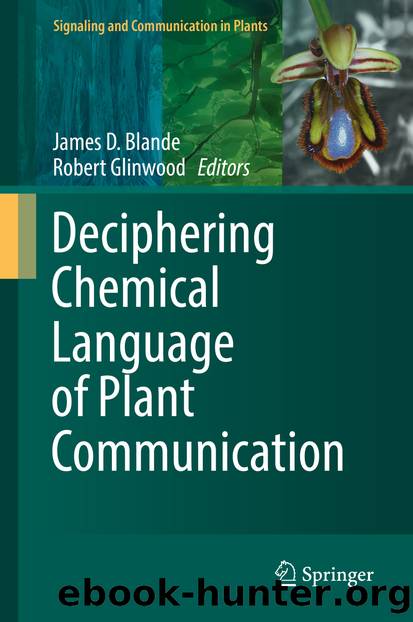Deciphering Chemical Language of Plant Communication by James D. Blande & Robert Glinwood

Author:James D. Blande & Robert Glinwood
Language: eng
Format: epub
Publisher: Springer International Publishing, Cham
7.6 Future Research
While the concept of plantâplant communication via volatiles underwent a long period of debate, there is now convincing evidence that plant VOCs hold ecologically relevant information that neighbouring plants, particularly close relatives, can recognise and respond to. Nevertheless, there are still many questions that need to be answered before we can attain a more holistic understanding of the phenomenon and the mechanisms behind it. The predisposition of most researchers to report statistically significant or âpositiveâ results may have also hindered our understanding of this phenomenon. In order to further identify the signalling compounds that mediate plantâplant communication and the context in which information exchange between plants occurs, accurate reporting of experimental results, including negative results that do not conform to our current paradigms, is essential. Below, I outline some key areas where future efforts would offer great promise for discovery and even significant breakthroughs.
First, future research should continue characterising the bioactive volatile components in the VOC blends that reliably transmit information between plants, examining the specific qualitative and quantitative features of the compounds that plants perceive. Moreover, the interaction of different active compounds, the role of the whole VOC blend as well as the impact of background VOC noise also need to be evaluated. This knowledge is important as it can be exploited to tweak our current agricultural practices to make crops better defended against pests. For example, we can genetically modify plants to make them more sensitive to pest attack and more rapid at releasing key active compounds. When grown alongside field crops, these plants, like a âsentinelâ, would be the first to detect and react to danger, alarming neighbouring crop plants.
Second, more efforts need to be diverted into understanding the recognition and perception of volatile cues as well as the further signal transduction. The big challenge is to determine whether these signals are internalised and transduced by receptor-mediated processes, whether they interact with the plasma membrane to initiate signal transduction cascades or whether they are simply taken up by the plant and metabolised into defensive compounds. The characterisation of receptors that are able to detect volatile compounds remains the biggest challenge.
Third, the ecological and evolutionary significance and the fitness consequences of information exchange between plants are still largely unexplored. More studies in a variety of habitats and using more plant species with different life histories are needed to determine the prevalence and ecological importance of plantâplant VOC transmission. Although plants are clearly responsive to volatile cues, it remains unclear how frequently or reliably plant VOCs transmit information between plants in natural settings. The lifetime fitness consequences for both the VOC emitters and responders require thorough scrutiny, particularly under natural conditions. This will help to elucidate the adaptive functions of VOC emissions and the driving force in the evolution of plantâplant volatile communication.
Finally, the impacts of global change on the efficacy of plantâplant VOC transmission need to be further evaluated. VOC emissions vary substantially in nature due to abiotic factors such as temperature, wind and radiation and will become more variable and unpredictable under local and global change.
Download
This site does not store any files on its server. We only index and link to content provided by other sites. Please contact the content providers to delete copyright contents if any and email us, we'll remove relevant links or contents immediately.
| Automotive | Engineering |
| Transportation |
Whiskies Galore by Ian Buxton(41529)
Introduction to Aircraft Design (Cambridge Aerospace Series) by John P. Fielding(32888)
Small Unmanned Fixed-wing Aircraft Design by Andrew J. Keane Andras Sobester James P. Scanlan & András Sóbester & James P. Scanlan(32573)
Craft Beer for the Homebrewer by Michael Agnew(17933)
Turbulence by E. J. Noyes(7700)
The Complete Stick Figure Physics Tutorials by Allen Sarah(7138)
Kaplan MCAT General Chemistry Review by Kaplan(6595)
The Thirst by Nesbo Jo(6435)
Bad Blood by John Carreyrou(6274)
Modelling of Convective Heat and Mass Transfer in Rotating Flows by Igor V. Shevchuk(6222)
Learning SQL by Alan Beaulieu(6035)
Weapons of Math Destruction by Cathy O'Neil(5829)
Man-made Catastrophes and Risk Information Concealment by Dmitry Chernov & Didier Sornette(5646)
Digital Minimalism by Cal Newport;(5389)
Life 3.0: Being Human in the Age of Artificial Intelligence by Tegmark Max(5184)
iGen by Jean M. Twenge(5161)
Secrets of Antigravity Propulsion: Tesla, UFOs, and Classified Aerospace Technology by Ph.D. Paul A. Laviolette(4990)
Design of Trajectory Optimization Approach for Space Maneuver Vehicle Skip Entry Problems by Runqi Chai & Al Savvaris & Antonios Tsourdos & Senchun Chai(4839)
Electronic Devices & Circuits by Jacob Millman & Christos C. Halkias(4748)
